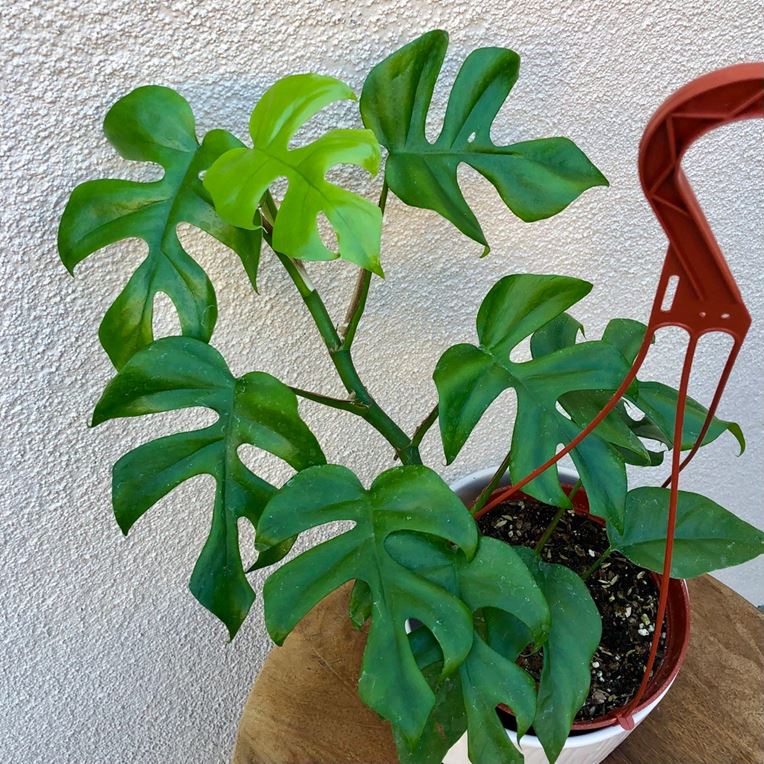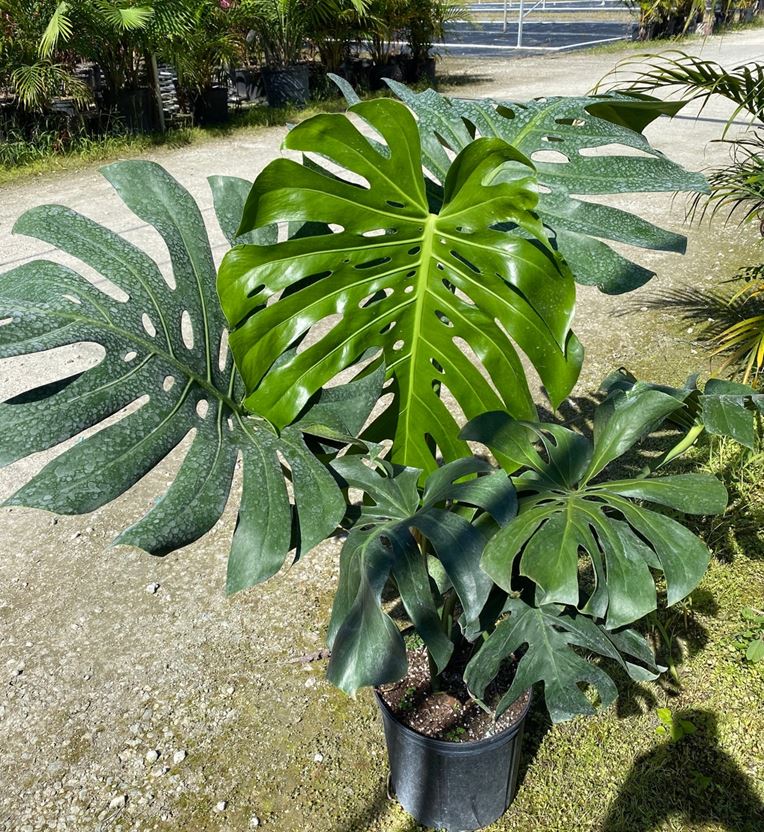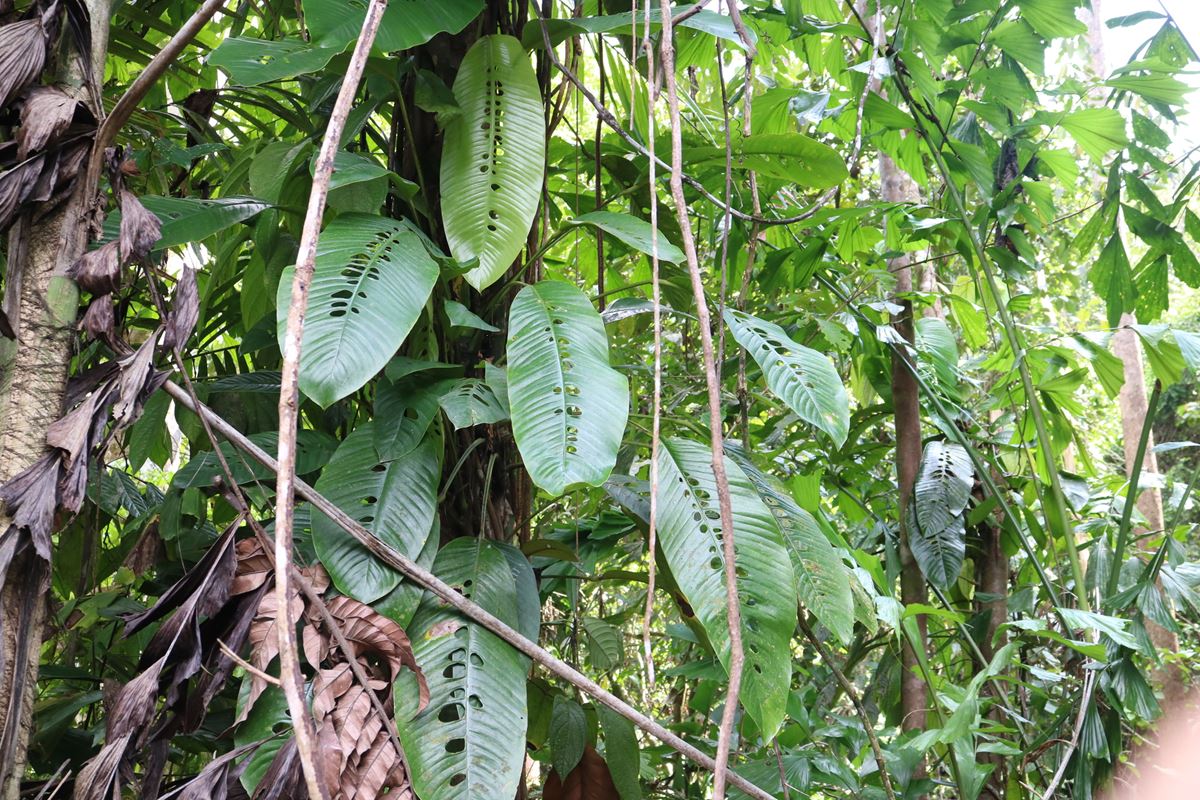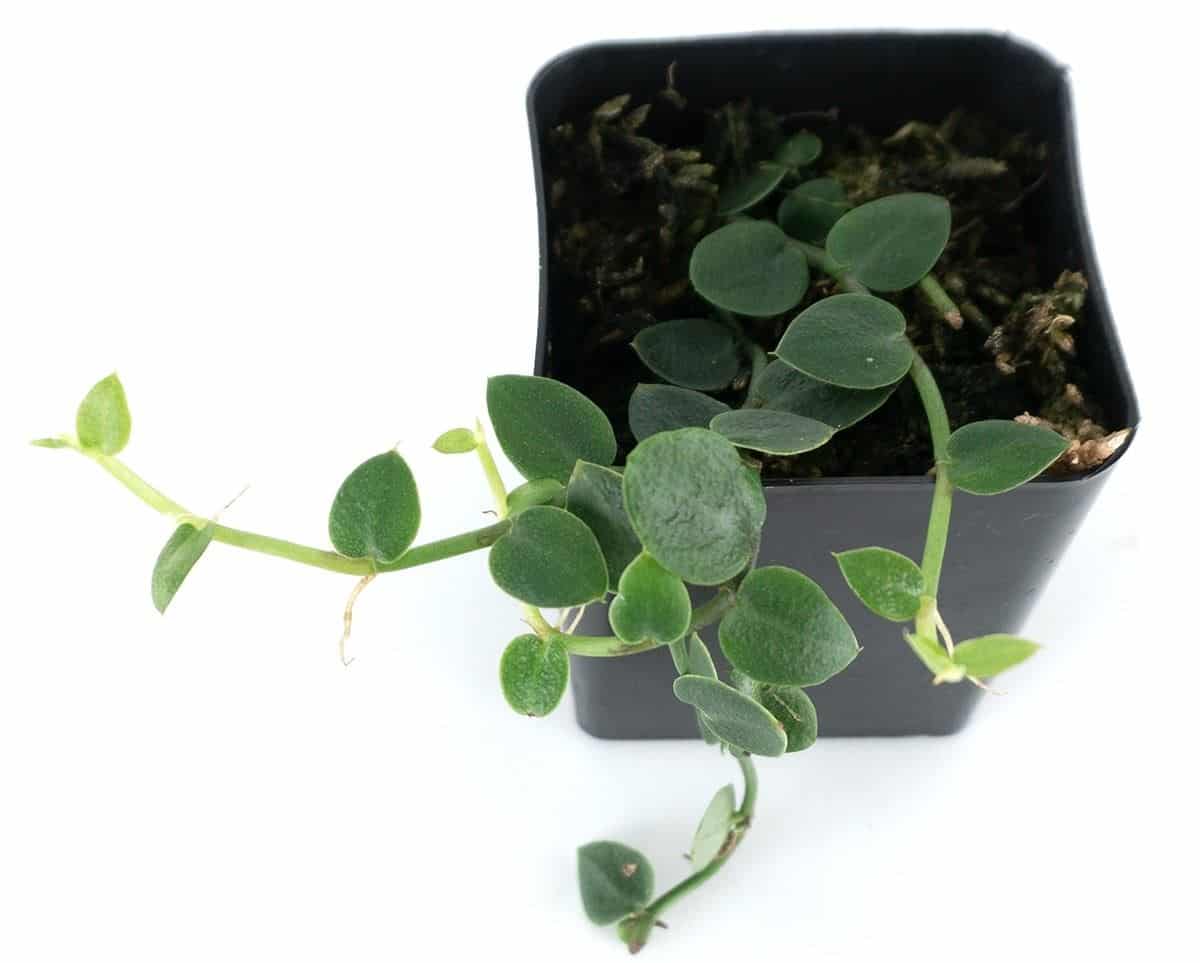Rhaphidophora tetrasperma vs. Monstera deliciosa will give you similarities and differences between these two plant species. It has to do with how leaves, stems, and flowers look and their growing habits.
We understand that early botanists thought that one was a miniature form of the other, i.e., tetrasperma was a smaller version of deliciosa. But these plants are different and you no longer need to keep confusing the two, yet they belong to different genera and obvious distinctions.
Learn more on the differences and similarities between these two houseplants that belong to the same family Araceae.

Contents
- About Rhaphidophora tetrasperma
- About Monstera deliciosa
- Similarities
- Rhaphidophora tetrasperma vs. Monstera deliciosa: Differences
- 1. Growing habits
- 2. Leaf size and shape
- 3. Leaf color, feel, or texture
- 4. Splits and fenestration (holes)
- 5. Petiole
- 6. Stems
- 7. Flowers and fruits
- 8. Dry leaves
- 9. Native habitat
- 10. Growth rate
- 11. Prices
- Quick summary
- Growth and care needs
About Rhaphidophora tetrasperma
Rhaphidophora tetrasperma, also known as Mini Monstera, Philodendron Ginny, Monstera Ginny, or Monstera minima, Philodendron minima, Philodendron piccolo is a houseplant native to Malaysia and Thailand. It has charming, deeply split leaves with wide pinnae and at times rhombic holes adjacent to the midrib.

It belongs to the tribe Monstereae and arum family Araceae (aroids). You will find the green form (original), variegated Rhaphidophora tetrasperma, and some tissue cultured plants.
About Monstera deliciosa
Monstera deliciosa (Swiss cheese plant, ceriman, split-leaf Philodendron, Mexican fruit bread) is a popular houseplant with giant deep green heart-shaped split and perforated leaves. Please note that Monstera adansonii and Monstera obliqua share the name Swiss-cheese plant.

It belongs to the tribe Monstereae in the Araceae family and is native to southern Mexico to Panama.
There are many M. deliciosa varieties, including M. deliciosa var. borsigiana, var. sierrana, sp. Brazil, among others. Also, you will find variegated forms (albo, aurea, and mint). Popular ones are Thai constellation, Monstera albo borsigiana, etc.
Similarities
Rhaphidophora tetrasperma is often referred to as the mini Monstera, Monstera minima, or Monstera ginny due to its resemblance with Monstera deliciosa.
R. tetrasperma and M. deliciosa are hemiepiphytes with terrestrial (ground) and epiphyte (on host) growth stages. They both have bisexual inflorescence flower borne on a spadix and surrounded by a spadix (modified leaf bract).
They belong to the same tribe, Monstereae, which means they are more closely related than even Philodendron and have both split and fenestrated (holes) leaves.
Last but not least, both these plants are toxic to humans and pets (cats, dogs, etc.) because they have needle-like insoluble calcium oxalate. These crystals will cause severe oral irritation, redness, and swelling. Also, patients will suffer from difficulty in swallowing, drooling, etc.
Rhaphidophora tetrasperma vs. Monstera deliciosa: Differences
To quickly tell the difference between Rhaphidophora tetrasperma and Monstera deliciosa, consider growing habits, leaf appearance (shape, color, splits, fenestration), and feel.
The petiole, stems, flowers, and plant growth rate will further tell you which one you have between these two plants.
Here are the differences:
1. Growing habits
R. tetrasperma is a small to medium, slender liana that can grow up to 16 feet (5 m) in the wild. In its seedling stage, it grows towards the light, juvenile stage shingles like m shingle like a Monstera dubia, i.e., they have short petiole, grow appressed to the surface, and leaves may slightly overlap.
On the other hand, M. deliciosa is a stout, large (grows up to 70 feet) sprawling epiphytic or rupestral plant. It doesn’t shingle in the juvenile stage, i.e., it has leaves with long (2-4 times longer than lamina) erect petiole at this stage.
2. Leaf size and shape
The leaf size and shape are the easiest to tell the difference between Rhaphidophora tetrasperma and Monstera deliciosa.
R. tetrasperma has smaller leaves, hence the name mini Monstera. They measure about 4.7-16.5 inches long and 3.7-15 inches wide and are oval to lance-oval shaped. Their bases truncate with some weakly heart-shaped, and the apex is acute to tapering to a point.
M. deliciosa, on the other hand, has giant heart-shaped leaves measuring 9-36 inches long and 9-30 inches wide. Their base is heart-shaped and apex acute to mucronate, i.e., abruptly end with mucro or short sharp point.
3. Leaf color, feel, or texture
If you have these two plants side by side, consider their leaf color feel or texture. Monstera deliciosa leaves will feel thicker and are leathery. Also, they are glossy deep green.
Rhaphidophora tetrasperma, on the other side, has thinner green leaves. Also, they don’t feel as leathery and are not as glossy.
4. Splits and fenestration (holes)
Both plants may have splits and may have holes. But Monstera deliciosa has more and evenly pinnatifid leaves that will have a series of 1-5 elliptic holes, except for rare cases where the perforations may be absent. Also, the sinuses (the gap between pinnae) are narrower than the pinnae.
On the other hand, R. tetrasperma has fewer splits with larger sinuses and thicker pinnae. Most plants don’t have holes. But in the case of fenestrations, they are few, rhombic in shape, and placed close to the midrib. Also, they don’t occur in series.
5. Petiole
The petiole of R. tetrasperma is slightly grooved and shorter (3.9 to 10.4 inches) than the lamina. It has a prominent upper and lower genicula (knee-like bent that enables plants to move leaves). Also, the petiole sheath extends to the base of the upper geniculum and afterward falls, leaving a somewhat corky scar.
It is a different story if you consider Monstera deliciosa. It’s a petiole that is longer than lamina (about 11.8-39.4 inches). Also, its petiolar sheath extends between 1/9 to 9/10 of the length. It may also fall or dry but remain in place.
Some M. deliciosa varieties may have a wrinkled edge on the geniculum near the lamina base. But if you have M. deliciosa var. borsigiana, it doesn’t have.
6. Stems
The other straightforward way to distinguish between M. deliciosa and R. tetrasperma is by looking at the stems.
Tetrasperma has thinner (less than an inch) stems with longer internode (2-4 inches). And the Swish cheese plant stems are thicker (0.8-3 inches) with shorter internodes (1.6-3.9 inches).
Both the leaves are alternating in both plants, but R. tetrasperma appears weakly spiral. A possible reason is the presence of the basal and apical genicula.
7. Flowers and fruits
If you are lucky to find these plants in the wild, it will be much easier to distinguish them considering their flowers and fruits. They both have bisexual inflorescence flowers borne on a spadix and surrounded by a spathe.
Now to the differences, M. deliciosa has a white or green larger spadix at anthesis that turns green or bluish-green in the fruiting stage. Also, its cream or white to yellow spathe is more prominent, and the larger spheroidal seeds resemble a large pea. Did you know that fully ripened Monstera deliciosa fruits are edible? Now you know.
On the other hand, R. tetrasperma has a smaller spadix with tiny white inflorescence flower and a smaller canoe-shaped white spathe that falls shifty after anthesis. Also, as the flowers emerge, two prominent cataphylls subtend and may remain after spathe falls but dry and turn black.
8. Dry leaves
Unlike Monstera plant species, whose leaves turn brown when dry, the Rhaphidophora plants leaves turn dark brown if you dry them.
9. Native habitat
While they may bear some resemblance, it’s good to note that these two plants come from different geographical locations. Whereas R. tetrasperma is from Asia, particularly Thailand and Malaysia, Monstera is from tropical America and surrounding islands.
10. Growth rate
Tetrasperma has a fast growth rate (able to increase by more than 2 feet per growing season) while the Monstera growth rate is moderate (increases by between 1 and 2 feet per growing season).
11. Prices
Tetrasperma is a bit cheaper selling for $10 to $25 compared to deliciosa whose price range is $15 to $40. But the exact price depends on where you buy your plant and its size.
Quick summary
Here is a quick summary of Rhaphidophora tetrasperma vs. Monstera deliciosa
| Rhaphidophora tetrasperma | Monstera deliciosa | |
| Growing habits | Vine-like, small to medium less leafy liana that shingle in the juvenile stage | A stout, large, climbing plant that sprawls that doesn’t shingle. |
| Leaf size | Smaller, oval to lance-oval shaped | Giant, heart-shaped leaves |
| Leaf color and feel | Thinner, less leathery green leaves | Thicker, leathery, glossy deep green leaves |
| Splits and fenestrations | Pinnatifid leaves that may rarely have rhombic holes near the midrib | Split and have a series of 1-5 elliptical holes. But the splits are narrower than pinnae. |
| Petiole | Shorter, grooved with petiolar sheath reaching apical geniculum base | Longer petiole with a deciduous or marcescent sheath. |
| Stems | Thinner with longer internodes | Thicker with shorter internodes |
| Flowers | It has a white inflorescent with a white canoe-shaped spadix that falls fast. The spadix and spathe are smaller. | It has white or green inflorescences and a cream or white to yellow spathe. Both the spadices and spathe are larger. |
| Dry leaves | Dark brown | Brown |
| Native habitat | Neotropical | Thailand and Malaysia |
| Growth rate | Fast | Moderate |
| Price | Cheap | Expensive |
Growth and care needs
The growth and care needs for R. tetrasperma and M. deliciosa are similar. But bear in mind that tetrasperma grows faster than deliciosa.
They both need bright, indirect light and a warm and humid area. But M. deliciosa requires slightly higher humidity, 50-60% or more, while mini Monstera can thrive in average house humidity, i.e., 40-50%.
These plants both need slightly acidic to neutral, well-drained, airy soil rich in organic matter. An aroid mix (see Etsy.com will work well) for both plants.
Also, their fertilizer needs are similar, i.e., they need moderate feeding (once a month with balanced, liquid houseplant fertilizer during growing months). However, you can feed tetrasperma more often since it grows faster.
That is not all. Both the plants have similar watering needs, and you should water them when the top 1-2 inches of the potting mix is dry. Of course, tetrasperma will need frequent watering since it grows faster. But always feed their soil.
Last but not least, they will both appreciate a place to climb, and other care needs, including pruning, are similar. But tetrasperma more often needs potting since it grows much faster.





Leave a Reply